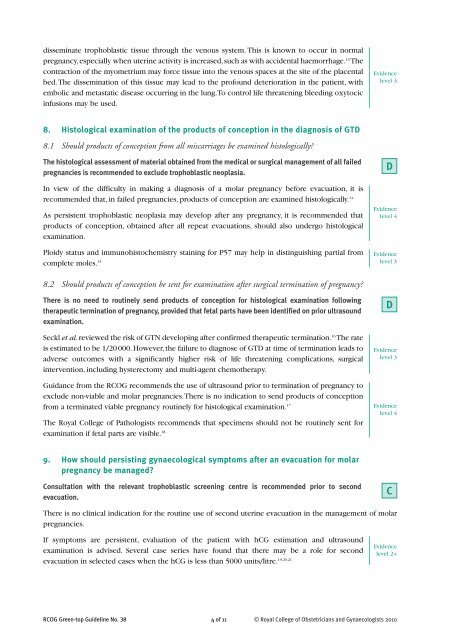The Management of Gestational Trophoblastic Disease - Green-top 38
The Management of Gestational Trophoblastic Disease - Green-top 38
The Management of Gestational Trophoblastic Disease - Green-top 38
You also want an ePaper? Increase the reach of your titles
YUMPU automatically turns print PDFs into web optimized ePapers that Google loves.
disseminate trophoblastic tissue through the venous system. This is known to occur in normal<br />
pregnancy, especially when uterine activity is increased, such as with accidental haemorrhage. 13 <strong>The</strong><br />
contraction <strong>of</strong> the myometrium may force tissue into the venous spaces at the site <strong>of</strong> the placental<br />
bed. <strong>The</strong> dissemination <strong>of</strong> this tissue may lead to the pr<strong>of</strong>ound deterioration in the patient, with<br />
embolic and metastatic disease occurring in the lung. To control life threatening bleeding oxytocic<br />
infusions may be used.<br />
Evidence<br />
level 3<br />
8. Histological examination <strong>of</strong> the products <strong>of</strong> conception in the diagnosis <strong>of</strong> GTD<br />
8.1 Should products <strong>of</strong> conception from all miscarriages be examined histologically?<br />
<strong>The</strong> histological assessment <strong>of</strong> material obtained from the medical or surgical management <strong>of</strong> all failed<br />
pregnancies is recommended to exclude trophoblastic neoplasia.<br />
In view <strong>of</strong> the difficulty in making a diagnosis <strong>of</strong> a molar pregnancy before evacuation, it is<br />
recommended that, in failed pregnancies, products <strong>of</strong> conception are examined histologically. 14<br />
As persistent trophoblastic neoplasia may develop after any pregnancy, it is recommended that<br />
products <strong>of</strong> conception, obtained after all repeat evacuations, should also undergo histological<br />
examination.<br />
Ploidy status and immunohistochemistry staining for P57 may help in distinguishing partial from<br />
complete moles. 15<br />
D<br />
Evidence<br />
level 4<br />
Evidence<br />
level 3<br />
8.2 Should products <strong>of</strong> conception be sent for examination after surgical termination <strong>of</strong> pregnancy?<br />
<strong>The</strong>re is no need to routinely send products <strong>of</strong> conception for histological examination following<br />
therapeutic termination <strong>of</strong> pregnancy, provided that fetal parts have been identified on prior ultrasound<br />
examination.<br />
Seckl et al. reviewed the risk <strong>of</strong> GTN developing after confirmed therapeutic termination. 16 <strong>The</strong> rate<br />
is estimated to be 1/20 000. However, the failure to diagnose <strong>of</strong> GTD at time <strong>of</strong> termination leads to<br />
adverse outcomes with a significantly higher risk <strong>of</strong> life threatening complications, surgical<br />
intervention, including hysterectomy and multi-agent chemotherapy.<br />
Guidance from the RCOG recommends the use <strong>of</strong> ultrasound prior to termination <strong>of</strong> pregnancy to<br />
exclude non-viable and molar pregnancies. <strong>The</strong>re is no indication to send products <strong>of</strong> conception<br />
from a terminated viable pregnancy routinely for histological examination. 17<br />
<strong>The</strong> Royal College <strong>of</strong> Pathologists recommends that specimens should not be routinely sent for<br />
examination if fetal parts are visible. 18<br />
D<br />
Evidence<br />
level 3<br />
Evidence<br />
level 4<br />
9. How should persisting gynaecological symptoms after an evacuation for molar<br />
pregnancy be managed?<br />
Consultation with the relevant trophoblastic screening centre is recommended prior to second<br />
evacuation.<br />
C<br />
<strong>The</strong>re is no clinical indication for the routine use <strong>of</strong> second uterine evacuation in the management <strong>of</strong> molar<br />
pregnancies.<br />
If symptoms are persistent, evaluation <strong>of</strong> the patient with hCG estimation and ultrasound<br />
examination is advised. Several case series have found that there may be a role for second<br />
evacuation in selected cases when the hCG is less than 5000 units/litre. 19,20,21<br />
Evidence<br />
level 2+<br />
RCOG <strong>Green</strong>-<strong>top</strong> Guideline No. <strong>38</strong> 4<strong>of</strong> 11<br />
© Royal College <strong>of</strong> Obstetricians and Gynaecologists 2010
















